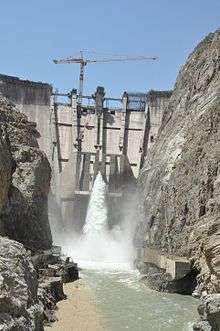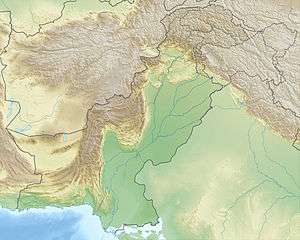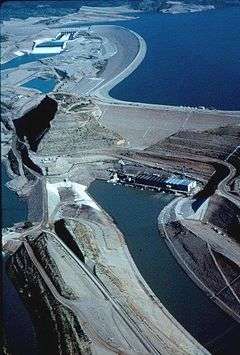Gomal Zam Dam
| Gomal Zam Dam | |
|---|---|
 Construction of the Gomal Zam Dam on 21 April 2011 | |
 Location of Gomal Zam Dam in Pakistan | |
| Official name | Gomal Zam Dam |
| Location | Khjori Kach, South Waziristan Agency, Federally Administered Tribal Areas, Pakistan |
| Coordinates | 32°05′55″N 69°52′53″E / 32.09861°N 69.88139°ECoordinates: 32°05′55″N 69°52′53″E / 32.09861°N 69.88139°E |
| Purpose | Irrigation, power, flood control |
| Status | Operational |
| Construction began | 2001 |
| Opening date | 2011 |
| Owner(s) | Government of Pakistan |
| Operator(s) | Water and Power Development Authority (WAPDA) |
| Dam and spillways | |
| Type of dam | Curved gravity, roller-compacted concrete |
| Impounds | Gomal River |
| Height | 437 ft (133 m) |
| Length | 758 ft (231 m) |
| Reservoir | |
| Total capacity | 1,140,000 acre feet (1.41 km3) |
| Active capacity | 890,000 acre feet (1.10 km3) |
| Inactive capacity | 250,000 acre feet (0.31 km3)[1] |
| Power station | |
| Commission date | 12 September 2013 |
| Turbines | 2 x 8.7 MW Francis-type[2] |
| Installed capacity | 17.4 MW (max. planned) |
Gomal Zam Dam is a multi-purpose gravity dam in South Waziristan Agency of Federally Administered Tribal Areas, Pakistan. The dam impounds the Gomal River, a tributary of the Indus River, at Khjori Kach, where the Gomal River passes through a narrow ravine. The purpose of the dam is irrigation, flood control and hydroelectric power generation.[3] Construction of the dam began in August 2001 and was completed in April 2011.[4] The powerhouse was completed in March 2013[5] and electricity production started in August 2013.[6] The dam was officially inaugurated on 12 September 2013 by Minister for Water and Power Khawaja Muhammad Asif, along with the US Ambassador Richard G. Olson and Khyber Pakhtunkhwa Governor Shaukatullah Khan.[7]
Features
Gomal Dam is a roller-compacted concrete (RCC) gravity dam with a height of 437 feet (133 m).[8] It has a gross storage capacity of 1,140,000 acre feet (1.41 km3) and the 60.5 km long main canal will irrigate about 163,000 acres (660 km2)[4] barren land of Tank district and Tehsil Kulachi of Dera Ismail Khan. It produces 17.4 MW of electricity.[6]
Background
The dam site at Khjori was first envisaged by four British officers of the Royal Corps of Engineers in 1898 and surveys were carried out. The Government of Pakistan approved the construction of the dam in August 1963 and preparatory work was commenced. However, it was stopped due to the outbreak of the 1965 Indo-Pak War and by subsequent budgetary constraints.[2] However, in 2001, the local Provincial Minister Aminullah Gandapur brought the delay in the construction of the dam to the notice of the then President of Pakistan, General Pervez Musharraf, who ordered its construction. The groundbreaking ceremony was held on 14 August 2001.
Finances and construction
In 2002, Pakistan's Water and Power Development Authority (WAPDA) hired a Chinese joint venture, CWHEC-HPE, to lead construction at a cost of about Rs. 4.388 billion. The venture joined China National Water Resources & Hydropower Engineering Corporation and Harbin Power Engineering Company. Work halted in October 2004 when two Chinese engineers were kidnapped by Tehrik-i-Taliban Pakistan militants. One was later rescued but the other killed in the attempt. Work resumed in 2007, after Pakistan put its army's construction branch, the Frontier Works Organisation, in charge. It hired as sub-contractors China's state-owned Sinohydro Corporation to complete the dam, and Turkey's Tekser to finish irrigation works. The total cost of the resumed project was stated to be around Rs. 13 billion.[9]
In July 2010, the United States Agency for International Development (USAID) announced it would provide funding for the dam.[10] Further delay to the project was caused by the 2010 Pakistan floods.[11]
In October 2010, the construction work on the dam was reported to be 92 percent complete. It was also stated to start operating from April 2011.[11]
In January 2011, USAID signed an agreement with WAPDA to provide $40 million to help complete the under-construction Gomal Zam Dam & powerhouse. The first tranche of $20 million was released to WAPDA in February 2011.[12] Another $20 million were provided to complete the main dam and the powerhouse.[5]
Construction of the Dam was completed in April 2011[4] and filling of the reservoir was started in the same month.[13] Eight more dam workers were kidnapped by Tehrik-i-Taliban Pakistan militants on 15 August 2012.[14] Seven of the eight workers were released on 14 September 2013 after the Pakistani government paid a heavy ransom of Rs. 25 million to the ‘commander Latif’ group of Tehrik-i-Taliban Pakistan. The fate of the eighth kidnapped employee is unknown.[15]
Another $40 million are also being provided by the USAID for completion of the irrigation and flood protection component of the project.[5] In January 2013, the irrigation and flood protection component was stated to be "almost near completion".[3]
The powerhouse was completed in March 2013[5] and the electricity production started in August 2013.[6] The Gomal Zam Dam was officially inaugurated on 12 September 2013.[7]
Waran Canal System
On 12 September 2012, WAPDA and USAID signed an agreement for the construction of Waran Canal System in Tank district of Khyber Pakhtunkhwa province. Under the agreement, USAID will provide $12 million funding for construction of the 164 km long Waran Canal system to bring 28,000 acres barren land under permanent irrigation.[16] In January 2013, WAPDA started the construction of Waran Canal system as an integral component of Gomal Zam Dam project. On completion, the canal will irrigate 28,000 acres land in the district which would increase crop sowing in the area from 26 percent to 87 percent and harvesting intensity from 9 percent to 80 percent.[17] The Waran Canal, in addition to Gomal Zam Dam's main canal, will bring a total of 191,000 acres land under permanent irrigation in Dera Ismail Khan & Tank districts of Khyber Pakhtunkhwa province.[18]
See also
- List of dams and reservoirs in Pakistan
- List of power stations in Pakistan
- Satpara Dam
- Khan Khwar Hydropower Project
- Allai Khwar Hydropower Project
References
- ↑ "Gomal Zam Dam Multipurpose Project" (PDF). Water and Power Development Authority. Retrieved 23 February 2013.
- 1 2 "Hydroelectric Power Plants in Pakistan". industcards.com. IndustCards. Retrieved 23 February 2013.
- 1 2 "Gomal Zam to be ready by end of January". The Express Tribune. 18 January 2013. Retrieved 29 August 2013.
- 1 2 3 "Gomal Zam project's main dam completed". Daily Times (Pakistan). 29 April 2011. Retrieved 29 August 2013.
- 1 2 3 4 "Gomal Zam Power House completed". The Express Tribune. 28 March 2013. Retrieved 29 August 2013.
- 1 2 3 "Gomal Zam Dam starts power generation". Dawn. 29 August 2013. Retrieved 29 August 2013.
- 1 2 "Gomal Zam dam in South Waziristan inaugurated". Dawn. 12 September 2013. Retrieved 13 September 2013.
- ↑ "GOMAL ZAM DAM MULTIPURPOSE PROJECT". Water and Power Development Authority. Retrieved 29 August 2013.
- ↑ "Runner-up bidder to get Gomal Dam contract". Dawn. 28 September 2005. Retrieved 17 October 2007.
- ↑ "The United States Announces Phase II of the Signature Energy Program for Pakistan". U.S. State Department. 19 July 2010. Retrieved 20 October 2010.
- 1 2 "Floods Delay U.S., China-Built Dam in Power-Starved Pakistan's Northwest". Bloomberg News. 1 October 2010. Retrieved 19 October 2010.
- ↑ "USAID releases $20 million for Gomal Zam Dam project". PakTribune. 8 February 2011. Retrieved 31 August 2013.
- ↑ "Filling of Gomal Zam dam begins". Dawn. 23 April 2011. Retrieved 29 August 2013.
- ↑ "Eight Gomal Zam Dam workers kidnapped". The News International. 16 August 2012. Retrieved 23 February 2013.
- ↑ "Ransom paid for workers' release". Dawn. 16 September 2013. Retrieved 22 September 2013.
- ↑ "USAID, Wapda ink $12m agreement". The Nation (Pakistan). 13 September 2012. Retrieved 14 September 2013.
- ↑ "Wapda begins construction of Waran Canal System: chairman". Business Recorder. 25 January 2013. Retrieved 14 September 2013.
- ↑ "US offers $12m for Waran canal construction project". Oman Tribune. Retrieved 14 September 2013.
